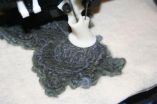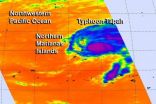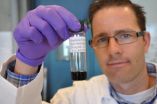(Press-News.org) New research out of UC San Francisco is the first to demonstrate that highly stressed people who eat a lot of high-fat, high-sugar food are more prone to health risks than low-stress people who eat the same amount of unhealthy food.
"Chronic stress can play an important role in influencing biology, and it's critical to understand the exact pathways through which it works." said Kirstin Aschbacher, PhD, an assistant professor in the UCSF Department of Psychiatry and lead author. "Many people think a calorie is a calorie, but this study suggests that two women who eat the same thing could have different metabolic responses based on their level of stress. There appears to be a stress pathway that works through diet – for example, it could be similar to what we see in animals, where fat cells grow faster in response to junk food when the body is chronically stressed."
Metabolic syndrome is a cluster of abnormalities— increased blood pressure, a high blood sugar level, excess body fat around the waist and abnormal cholesterol levels — that occur together, increasing a person's risk of heart disease, stroke and diabetes.
While this stress-junk food pathway has been well mapped out with rodents and primates, this study is the first to suggest the same pathways may be at work in chronically stressed humans, according to the researchers.
"We can see this relationship exists by simply measuring stress and dietary intake, and looking inside at metabolic health," said senior author Elissa Epel. "Diet appears to be a critical variable that can either amplify or protect against the metabolic effects of stress, but we still don't know the details of how much it takes. It will be helpful to see what happens in our next study, when we have high stress people eat a high sugar diet for a couple weeks."
The study, published online in the journal Psychoneuroendocrinology, looked at a group of 61 disease-free women; 33 were chronically stressed women caring for a spouse or parent with dementia, and 28 were women with low stress. Over the course of a year, the women reported their consumption of high sugar, high fat foods.
The researchers evaluated key biological markers associated with elevated metabolic risk. They measured participants' waistlines and their fat distribution, using ultrasound scans to assess deep abdominal fat deposits. They tested participants' insulin resistance, one of the core drivers of obesity and diabetes. They also used a blood test to measure stress hormones and oxidative damage to lipids and cell RNA, a marker that has predicted higher rates of death from diabetes. Oxidative damage of the genome is also an important outcome because it is one factor that can contribute to faster cellular aging.
"We found that more frequent high fat, high sugar consumption significantly predicted a larger waistline, more truncal fat, higher oxidative damage, and more insulin resistance, but only among the group of women exposed to chronic stress," said Aschbacher. "The chronically stressed women didn't report eating more high sugar, high fat foods than the low stressed women; however, they did have higher levels of a stress-related biomarker, peripheral Neuropeptide Y (NPY)."
Based on what is known from animal studies, stress triggers greater peripheral NPY which, in combination with junk food, creates larger abdominal fat cells, and these cells may be more prone to metabolic dysregulation.
"The medical community is starting to appreciate how important chronic stress is in promoting and worsening early disease processes," said Aschbacher. "But there are no guidelines for 'treating' chronic stress. We need treatment studies to understand whether increasing stress resilience could reduce the metabolic syndrome, obesity or diabetes."
INFORMATION:
The study was supported by grants from the National Institutes of Health, the Marchionne Foundation and The Institute for Integrative Health.
Additional contributors to the study are Sarah Kornfeld, MA, Alliant International University; Martin Picard, PhD, Children's Hospital of Philadelphia; Eli Puterman, PhD, Department of Psychiatry at UCSF; Peter Havel, DVM, PhD, University of California, Davis; Kimber Stanhope, PhD, University of California, Davis; and Robert Lustig, MD, Department of Pediatrics at UCSF.
UCSF is a leading university dedicated to promoting health worldwide through advanced biomedical research, graduate-level education in the life sciences and health professions, and excellence in patient care. It includes top-ranked graduate schools of dentistry, medicine, nursing and pharmacy, a graduate division with nationally renowned programs in basic biomedical, translational and population sciences, as well as a preeminent biomedical research enterprise and two top-ranked hospitals, UCSF Medical Center and UCSF Benioff Children's Hospital San Francisco.
Chronic stress heightens vulnerability to diet-related metabolic risk
2014-04-29
ELSE PRESS RELEASES FROM THIS DATE:
GWAS study ties ABCC9 anomalies, sulfonylurea exposure to HS-Aging
2014-04-29
LEXINGTON, Ky. (April 29, 2014) -- A genome-wide association study (GWAS) led by Peter Nelson, MD, PhD, of the Sanders-Brown Center on Aging at the University of Kentucky, and David Fardo, PhD, of UK's Department of Biostatistics, has provided new insight into Hippocampal Sclerosis of Aging (HS-A), a common disease affecting the elderly.
Researchers from 16 different institutions compared 363 persons with autopsy-proven HS-A to a control group of 2,303 other individuals in an attempt to identify genetic predisposition to HS-Aging.
Dr. Nelson and his team found that ...
Carnegie Mellon-Disney researcher invents 3-D printing technique for making cuddly stuff
2014-04-29
PITTSBURGH—Soft and cuddly aren't words used to describe the plastic or metal things typically produced by today's 3D printers. But a new type of printer developed by Carnegie Mellon University and Disney Research Pittsburgh can turn wool and wool blend yarns into fabric objects that people might actually enjoy touching.
The device looks something like a cross between a 3D printer and a sewing machine and produces 3D objects made of a form of loose felt. Scott Hudson, a professor in CMU's Human-Computer Interaction Institute who developed the felting printer with Disney ...
Beyond graphene: Controlling properties of 2-D materials
2014-04-29
The isolation of graphene at the University in 2004 led to the discovery of many other 2D crystals. While graphene has an unrivalled set of superlatives, these crystals cover a large range of properties: from the most conductive to isolating, from transparent to optically active.
The next step is to combine several of these crystals in a 3D stack. This way, one can create 'heterostructures' with novel functionalities – capable of delivering applications as yet beyond the imagination of scientists and commercial partners.
The first examples of such heterostructures already ...
Scripps Florida scientists reveal molecular secrets behind resveratrol's health benefits
2014-04-29
JUPITER, FL, April 29, 2014 – Resveratrol has been much in the news as the component of grapes and red wine associated with reducing "bad cholesterol," heart disease and some types of cancer. Also found in blueberries, cranberries, mulberries, peanuts and pistachios, resveratrol is associated with beneficial health effects in aging, inflammation and metabolism.
Scientists from the Florida campus of The Scripps Research Institute (TSRI) have now identified one of the molecular pathways that resveratrol uses to achieve its beneficial action. They found that resveratrol ...
Tapah through infrared satellite eyes: Now a typhoon
2014-04-29
Tropical Storm Tapah strengthened since April 28 and early on April 29, the storm reached typhoon strength. From its orbit in space, NASA's Aqua satellite zoomed over Tapah and the AIRS instrument captured infrared data on the storm that showed the location of its strongest thunderstorms.
The U.S. National Weather Service in Guam noted that a tropical storm warning and a typhoon watch continues for Alamagan and Pagan. For details on the advisory, visit: http://www.prh.noaa.gov/data/GUM/HLSPQ1
The Atmospheric Infrared Sounder (AIRS) instrument that flies aboard NASA's ...
Graphene not all good
2014-04-29
RIVERSIDE, Calif. — In a first-of-its-kind study of how a material some think could transform the electronics industry moves in water, researchers at the University of California, Riverside Bourns College of Engineering found graphene oxide nanoparticles are very mobile in lakes or streams and therefore likely to cause negative environmental impacts if released.
Graphene oxide nanoparticles are an oxidized form of graphene, a single layer of carbon atoms prized for its strength, conductivity and flexibility. Applications for graphene include everything from cell phones ...
Rice U. study: How state ownership hampered entrepreneurship in Chinese companies
2014-04-29
HOUSTON – (April 29, 2014) – For state-owned companies in China, the significant detriment in employing innovation may be linked to the company's ownership structure, according to a new study on Chinese entrepreneurship by Chinese business experts at Rice University, the University of Hong Kong, Texas Christian University, Jilin University and Shantou University.
The researchers found that the more equity the state owned of a company, the less likely the company was to engage in strategic entrepreneurship (investing in research and development and other innovations) to ...
Anti-smoking TV ads should use anger, Dartmouth-Cornell study suggests
2014-04-29
Anti-smoking television advertisements that appeal to viewers' emotions are more persuasive when they use anger rather than sadness, a Dartmouth-Cornell study suggests.
The study appears in the Journal of Health Communication. A PDF is available on request.
Previous studies have shown emotional expression is a crucial part of persuasion, and that audience members' perceptions of emotions affect their attitudes and behaviors. Previous research also has shown anti-smoking TV ads that convey negative emotions such as anger and sadness are more effective than non-emotional ...
'Feel good' factor higher when you own, not just use, luxury items
2014-04-29
It means more to people to own a luxury product or brand than to have the privilege of simply using one. Just using an affordable luxury item you don't own can, in fact, dampen the feel good factor that normally surrounds such products, say Liselot Hudders and Mario Pandelaere of Ghent University in Belgium. The research was published in Springer's journal Applied Research in Quality of Life.
To test the link between luxury consumption and subjective well-being, the researchers presented 307 study participants with luxury and ordinary versions of either a durable pen, ...
Solving a mystery of thermoelectrics
2014-04-29
CAMBRIDGE, Mass-- Materials that can be used for thermoelectric devices — those that turn a temperature difference into an electric voltage — have been known for decades. But until now there has been no good explanation for why just a few materials work well for these applications, while most others do not. Now researchers at MIT and elsewhere say they have finally found a theoretical explanation for the differences, which could lead to the discovery of new, improved thermoelectric materials.
The findings — by MIT graduate student Sangyeop Lee; Gang Chen, the Carl Richard ...



